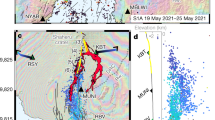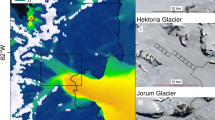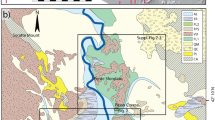Abstract
Volcanic eruptions under glaciers can cause dangerous floods and lahars1,2,3 and create hyaloclastite (fragmented glassy rock) mountains4,5,6,7,8. But processes such as the rate of heat transfer between ice and magma, edifice formation, and the response of the surrounding glacier are poorly understood, because of the lack of data. Here we present observations from the fissure eruption at Vatnajökull ice cap, Iceland, in October 1996. In the 13 days of the eruption 3 km3 of ice were melted and the erupted magma fragmented into glass forming a hyaloclastite ridge 6–7 km long and 200–300 m high under 500–750 m of ice. Meltwater of temperatures of 15–20 °C flowed along a narrow channel at the glacier bed into the Grímsvötn subglacial lake for five weeks, before draining in a sudden flood, or jökulhlaup. Subsidence and crevassing of the ice cap occurred over the eruptive fissure and the meltwater path, whereas elsewhere the glacier surface remained intact, suggesting that subglacial eruptions do not trigger widespread basal sliding in warm-based glaciers.
This is a preview of subscription content, access via your institution
Access options
Subscribe to this journal
Receive 51 print issues and online access
$199.00 per year
only $3.90 per issue
Buy this article
- Purchase on Springer Link
- Instant access to full article PDF
Prices may be subject to local taxes which are calculated during checkout




Similar content being viewed by others
References
Major, J. J. & Newhall, C. H. Snow and ice perturbation during historical volcanic eruptions and the formation of lahars and floods. Bull. Volc. 15, 1–27 (1989).
Lowe, D. R. et al. Lahars initiated by the 13 November 1985 eruption of Nevado del Ruiz, Colombia. Nature 324, 51–53 (1986).
Thorarinsson, S. Vötnin strið (Menningarsjóður, Reykjavík, (1974)).
LeMasurier, W. E. in Volcanoes of the Antarctic Plate and Southern Oceans (eds LeMasurier, W. E. & Thomson, J. W.) 1–17 (AGU, Antarctic Research Series 48, (1990)).
Mathews, W. H. “Tuyas”, flat-topped volcanoes in northern British Columbia. Am. J. Sci. 245, 560–570 (1947).
Kjartansson, G. Árnesingasaga (Árnesingafélagið, Reykjavík, (1943)).
van Bemmelen, R. W. et al. Tablemountains of Northern Iceland (Brill, Leiden, (1955)).
Jones, J. G. Intraglacial volcanoes of the Laugarvatn region, south-west Iceland—I. Q. J. Geol. Soc. Lond. 124, 197–211 (1969).
Smellie, J. L. & Skilling, I. P. Products of subglacial volcanic eruptions under different ice thicknesses: two examples from Antarctica. Sedim. Geol. 91, 115–129 (1994).
Werner, R., Schminke, H. U. & Sigvaldason, G. Anew model for the evolution of table mountains: volcanological and petrological evidence from Herdubreid and Herdubreidartögl volcanoes (Iceland). Geol. Rundsch. 85, 390–397 (1996).
Jakobsson, S. P. On the consolidation and palagonitization of the tephra of the Surtsey volcanic island, Iceland. Surtsey Research Progress Rep. VI, 121–128 (Surtsey Research Society, Reykjavik, (1972)).
Jakobsson, S. P. Environmental factors controlling the palagonitization of the Surtsey tephra, Iceland. Bull. Geol. Soc. Denmark 27, 91–105 (1978).
Jakobsson, S. P. & Moore, J. G. Hydrothermal minerals and alteration rates at Surtsey volcano, Iceland. Geol. Soc. Am. Bull. 97, 648–659 (1986).
Einarsson, P. et al. Center of the Iceland hotspot experiences volcanic unrest. Eos 78, 374–375 (1997).
Björnsson, H. Subglacial water reservoirs, jökulhlaups and volcanic eruptions. Jökull 25, 1–14 (1975).
Yokoyama, I. Energetics in active volcanos. Tokyo Univ. Earthq. Res. Inst. Bull. 35, 75–97 (1957).
Shimozuru, D. Discussion on the energy partition of volcanic eruption. Bull. Volcanol. 32, 383–394 (1968).
Charmichael, I. S. E., Turner, F. J. & Verhogen, J. Igneous Petrology 128–130 (McGraw-Hill, New York, (1974)).
Moore, J. G. Mechanism of formation of pillow lava. Am. Sci. 63, 269–277 (1975).
Bacon, C. R. High temperature heat content and heat capacity of silicate glasses: Experimental determination and a model for calculation. Am. J. Sci. 277, 109–135 (1977).
Oddson, B. Rock quality designation and drilling rate correlated with lithology and degree of alteration in volcanic rocks from the 1979 Surtsey drill hole. Surtsey Research Progress Rep. IX, 94–97 (Surtsey Research Society, Reykjavik, (1982)).
Björnsson, H. Hydrology of ice caps in volcanic regions. Soc. Sci. Islandica 45, (Visindafélag Íslendinga, Reykjavik, (1988)).
Gudmundsson, M. T. & Björnsson, H. Eruptions in Grímsvötn, Vatnajökull, Iceland, 1934–1991. Jökull 41, 21–45 (1991).
Blankenship, D. D. et al. Active volcanism beneath the West Antarctic ice sheet and implications for ice-sheet stability. Nature 361, 526–529 (1993).
Kamb, B. et al. Glacier surge mechanism: 1982–1983 surge of Variegated Glacier, Alaska. Science 227, 469–479 (1985).
Björnsson, H. & Einarsson, P. Volcanoes beneath Vatnajökull, Iceland: Evidence from radio echo-sounding, earthquakes and jökulhlaups. Jökull 40, 147–168 (1990).
Björnsson, H., Björnsson, S. & Sigurgeirssoon, Th. Penetration of water into hot rock boundaries of magma at Grímsvötn. Nature 295, 580–581 (1982).
Gudmundsson, M. T., Björnsson, H. & Pálsson, F. Changes in jökulhlaup sizes in Grímsvötn, Vatnajökull, Iceland, 1934–91, deduced from in-situ measurements of subglacial lake volume. J. Glaciol. 41, 263–272 (1995).
Acknowledgements
We thank the Iceland Civil Aviation Authority, especially chief pilot S. Gudbjörnsson, the crews of the helicopters of the Icelandic Coast Guard and J. K. Björnsson of the Iceland Helicopter Service for enthusiastic cooperation during the monitoring of the eruption. F. Pálsson, H. Halldórsson, K. Pálsson, S. Jónsson and P. Símonarson took part in the GPS measurements and members of the Iceland Glaciological Society assisted in fieldwork in June 1997. The figures were prepared by Th. Högnadóttir. A review by D. Blankenship improved the paper.
Author information
Authors and Affiliations
Corresponding author
Rights and permissions
About this article
Cite this article
Gudmundsson, M., Sigmundsson, F. & Björnsson, H. Ice–volcano interaction of the 1996 Gjálp subglacial eruption, Vatnajökull, Iceland. Nature 389, 954–957 (1997). https://doi.org/10.1038/40122
Received:
Accepted:
Issue Date:
DOI: https://doi.org/10.1038/40122
This article is cited by
-
Implications of the study of subglacial volcanism and glaciovolcanic cave systems
Bulletin of Volcanology (2022)
-
Volcanoes and climate: the triggering of preboreal Jökulhlaups in Iceland
International Journal of Earth Sciences (2020)
-
A Reappraisal of Seismicity Recorded During the 1996 Gjálp Eruption, Iceland, in Light of the 2014–2015 Bárðarbunga–Holuhraun Lateral Dike Intrusion
Pure and Applied Geophysics (2020)
-
Ice-confined construction of a large basaltic volcano—Austurfjöll massif, Askja, Iceland
Bulletin of Volcanology (2019)
-
Possible deep connection between volcanic systems evidenced by sequential assimilation of geodetic data
Scientific Reports (2018)
Comments
By submitting a comment you agree to abide by our Terms and Community Guidelines. If you find something abusive or that does not comply with our terms or guidelines please flag it as inappropriate.



